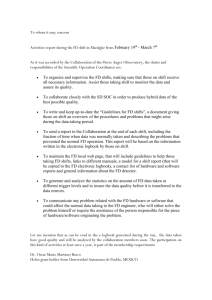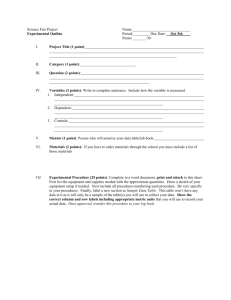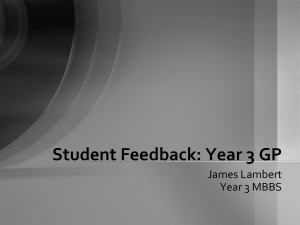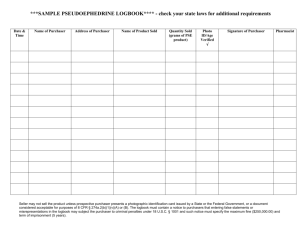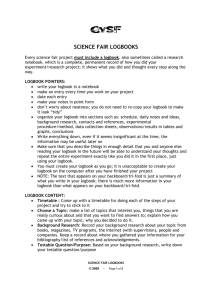Web Based Electronic Logbook and Experiment Run Database Viewer for Alcator C-Mod
advertisement
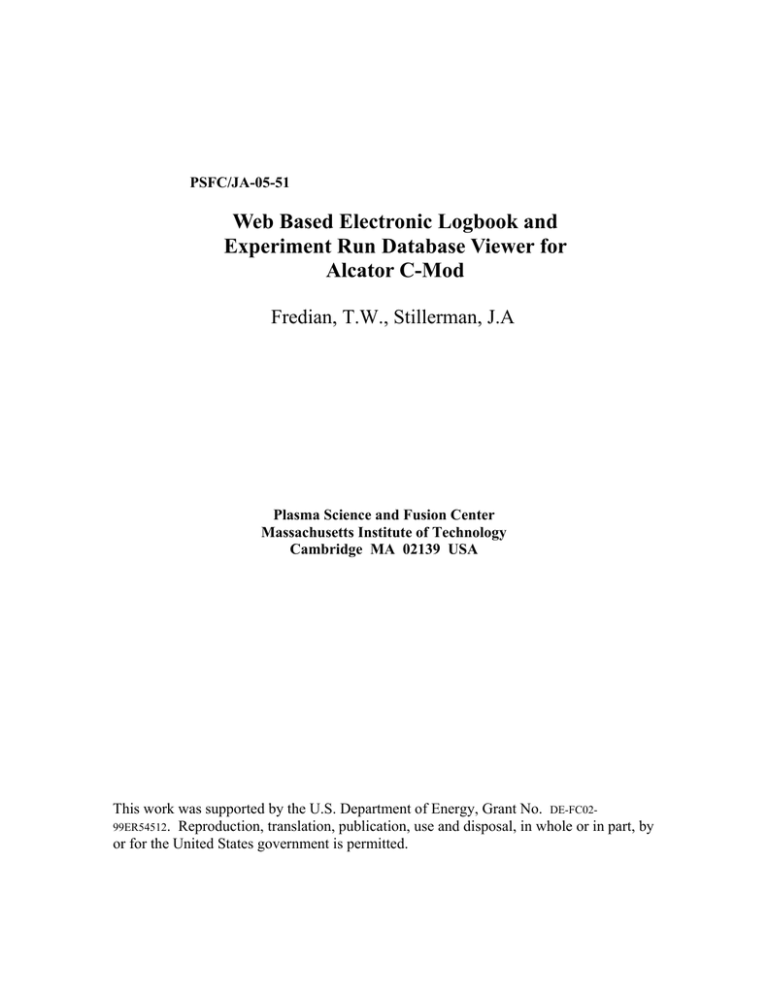
PSFC/JA-05-51 Web Based Electronic Logbook and Experiment Run Database Viewer for Alcator C-Mod Fredian, T.W., Stillerman, J.A Plasma Science and Fusion Center Massachusetts Institute of Technology Cambridge MA 02139 USA This work was supported by the U.S. Department of Energy, Grant No. DE-FC0299ER54512. Reproduction, translation, publication, use and disposal, in whole or in part, by or for the United States government is permitted. Web Based Electronic Logbook and Experiment Run Database Viewer for Alcator C-Mod T. W. Frediana*, J.A.Stillermana a Massachusetts Institute of Technology, 175 Albany Street, Cambridge, MA, 02139 Abstract Since 1991, the scientists and engineers at the Alcator C-Mod experiment at MIT have been recording text entries about the experiments being performed in an electronic logbook. In addition, separate documents such as run plans, run summaries and experimental proposals have been created and stored in a variety of formats in computer files. This information has now been organized and made available via any modern web browser. The new web based interface permits the user to browse through all the logbook entries, run information and even view some key data traces of the experiment. Since this information is being catalogued by Internet search engines, these tools can also be used to quickly locate information. The web based logbook and run information interface provides some additional capabilities. Once logged into the web site, users can add, delete or modify logbook entries directly from their browser. The logbook window on their browser also provides dynamic updating when any new logbook entries are made. There is also live C-Mod operation status information with optional audio announcements available. The user can receive the same state change announcements such as “entering init” or “entering pulse” as they would if they were sitting in the C-Mod control room. This paper will describe the functionality of the web based logbook and how it was implemented. Keywords: Remote Collaboration, Electronic Logbook, Alcator * Corresponding author. Tel: (617) 253-7623; fax: (617) 253-0627 E-mail address: twf@psfc.mit.edu. 1. Introduction Since the startup of the Alcator C-Mod experiment in 1991, the scientists and engineers have been recording information about the operation of the tokomak in various documents and databases. A logbook application had been developed enabling users to enter comments related to C-Mod runs and shots. These comments were stored in a relational database from which users could query, selecting comments based on topics, runs, shots, user name, date or text criteria. The logbook application was revised several times as more was learned about how users would interact with this information. In addition to the logbook entries, numerous other pieces of information such as mini-proposals, run plans, run summaries and operator comments were stored in various locations such as text files, database tables and formatted PDF files. Most of this information was only available if one logged into a local workstation and knew which application to use to view particular subsets of this information. Over the last ten years more of this information was eventually made available via various web server CGI scripts but there was no formal organization and it was often difficult or tedious to find related information about a given run or shot. During the last year there has been a concerted effort to consolidate this information, create logical links, and to make it available using a web browser. 2. Approach The process of consolidating the information related to the C-Mod experiment operation required several initiatives. One was to formalize the organization of the information such as run plans, run summaries, mini-proposals and the identification of key personnel, operators and session leaders, for each experiment operation. Much of this information was loaded into new relational database tables. Populating the new database tables was a tedious task since it required manually reviewing the existing documents and logbook entries to extract the desired information. Once the existing information for all of the C-Mod experiments previously carried out had been reorganized, new applications and procedures were developed and adopted to ensure that this information would be correctly entered and maintained for future C-Mod operation. Another major initiative was to port the CMod logbook application, formerly an IDL [1] application, to a web based application. This would enable users to query the logbook as well as make new entries using a web browser on any computer on the Internet, greatly improving the accessibility of this information for remote collaborators. 3. Technologies Utilized The existing Electronic Logbook application [2,3] was implemented using the IDL language and its interface to the Microsoft SQL Server[4] relational database. This interface was developed as part of the MDSplus[5] system. Since much of the C-Mod experiment information was already stored in tables in a MS SQL Server database, this database platform was also used for the additional tables required to organize all of the C-Mod information. The web based applications were developed using the PHP CGI scripting language[6]running in an Apache web server[7] on a RedHat Enterprise 3.0[8] linux server. The logbook application provides live updates when new logbook entries are entered and when state changes during the C-Mod operation cycles occur. To provide this updating capability a JAVA applet was utilized which recognizes MDSplus events and causes the web browser to execute JAVASCRIPT statements. Some of the new C-Mod shot web pages also contain dynamically generated data plots. These plots are generated using the JpGraph[9]PHP package to plot the data retrieved using an MDSplus PHP module. 4. Applications Several web based applications were developed to implement this consolidated view of the C-Mod Run information. The main application for view the information is the Logbook application (see Figure 1). This application allows users to customize their selection criteria so that they can view the information they are most interested (see Figure 2). The user preferences are stored in the relational database so they are applied whenever the user logs into the Logbook web page. The logbook web pages provide live C-Mod cycle state information (including optional audio announcements) and updates when new logbook entries are made. Figure 3 – Shot Display Figure 1 – Electronic Logbook Display Figure 2 – Selection Preferences Links to additional shot (see Figure 3) or run (see Figure 4) related information are included on the main logbook web page so a user can easily browse to more detailed information about a run or shot. The run information includes information such as the experimental “mini-proposals” executed for the run, the names of the key operators and session leaders as well as the key logbook entries made by these key operators and session leaders. The shot information includes plots of key signals and a table of all the logbook entries made pertaining to that shot. Links are provided to readily traverse all the C-Mod run and shot information. Figure 4 – Run Display A suite of “Sign on” applications were developed to enable the key operators and session leaders to sign on to record their identities in the database. The three key positions are Session Leader (scientist responsible to implementing the mini-proposal), Physics Operator (scientist/engineer responsible for manipulating key physics parameters such as plasma shape control) and Engineering Operator (engineer responsible for manipulating engineering controls such as power supplies). Another suite of applications were developed for managing the database tables which provide the linkage between all the various pieces of information. These table management applications were developed primarily for loading the information from the past CMod runs and for entering new mini-proposals into the database. 5. Future work The complete suite of applications is based on the PHP CGI scripting language used with the Apache web server. It uses the mssql plugin module to communicate with the C-Mod logbook database which resides on a MS Windows server in an MS SQL Server relational database. If other sites express interest in deploying the logbook application for their experiments and they would like to use a different database engine such as Open Source databases like PostGreSQL[10]or MySQL[11] the PHP code will be modified to enable support for these databases. There is a PHP extension package called PEAR DB[12] which provides a database abstraction layer between the application and the database specific modules. If these applications were ported to layer on top of PEAR DB package then other database engines could be used without major customization of the application code. A configurable Electronic Logbook package could be developed complete with SQL scripts for creating the necessary database tables for several different types of databases. Unlike the previous version of the logbook, the new logbook, being web based, permits the user to enter html tags in the logbook entry. Users can include references to images and other web pages in their logbook entries. There has been some discussion of providing a mechanism for “pasting” MDSplus dwscope panels into logbook entries using simple mouse click operations on the dwscope application and the web browser. A PHP script utilizing the MDSplus module and the JpGraph package was prototyped to be used as the html image source for the “pasted” plots. Extensions to the dwscope application would need to be added to paste the appropriate html code in the browser when inserting a plot into the logbook entry. 6. Conclusion The new suite of web based tools has proven to be very useful for organizing and presenting the information pertaining to the complete history of Alcator C-Mod experimental runs. Local scientists, engineers and remote collaborators can readily explore this information and quickly locate important records pertaining to specific C-Mod runs or shots. Placing this information on the web serves several purposes. The information is now available to a much larger audience. Users can access this information remotely using no extra software beside a web browser. Since the information is available on the Internet, many of the powerful search engines have indexed this information. We have found that web searches using engines such as GOOGLE can locate C-Mod run information much more quickly than doing local relational database queries. From a developmental viewpoint the PHP scripting language was found to be extremely powerful and easy to use. There is a large number of useful extension modules distributed with PHP which are well organized and documented. The PHP distribution includes the infrastructure for developing additional extensions. Developing the MDSplus PHP extension was quite straightforward and easy to implement. This extension makes it possible to easily generate web content based on any data accessible via MDSplus. The use of a java applet to execute JavaScript code seems to work well and provide automatic updates of the browser display. These web applications work on most of the popular browsers such as IE, Netscape, Mozilla, Safari and Firefox. The logbook application can be viewed at https://www.psfc.mit.edu/research/alcator/logbook.ph p. If one has a C-Mod database account the user can log in using that account. If one cancels on the login page the user will gain anonymous access. This will enable browsing of the information but will not permit the addition or modification of logbook entries. Note that the logbook application runs a java applet to monitor MDSplus events which connects to the web server host using port 8001. If run behind a firewall that blocks this connection it may cause the browser to hang. The browser should be configured to enable both JAVASCRIPT and Java for the application to function properly. Acknowledgements This work was supported by the U.S. Department of Energy, Cooperative Grant No. DE-FC0299ER54512. Much of this work would not have been possible without the extremely useful feedback provided by Alcator C-Mod scientists, especially Steve Wolfe and Martin Greenwald. References [1] [2] [3] IDL, Research Systems Inc, http://www.rsinc.com, accessed May 24, 2005 T.W. Fredian, J.A. Stillerman, M. Greenwald, “Data acquisition system for Alcator C-Mod”, Rev. Sci. Inst., January 1997, 68(1), pp 935-938. J.A. Stillerman, T.W. Fredian, M. Greenwald, “WWW interfaces for runtime relational database applications”, Fus. Eng. Des., 48, 2000, pp. 63-68. [4] Microsoft SQL Server, http://www.microsoft.com/sql/default.mspx, Accessed May 24, 2005 [5] T. W. Fredian and J. A. Stillerman, "MDSplus: Current Developments and Future Directions", Fus. Eng. Des., 60, (2002), 229 [6] PHP, http://www.php.net/, accessed May 24, 2005 [7] Apache Web Server, http://httpd.apache.org/, accessed May 14, 2005 [8] RedHat Enterprise Linux, http://www.redhat.com/software/rhel/, Accessed May 24, 2005 [9] JpGraph, http://www.aditus.nu/JpGraph/, accessed May 24, 2005 [10] PostGreSQL, http://www.postgresql.org/, accessed May 24, 2005 [11] MySQL, http://www.mysql.com/, accessed May 24, 2005 [12] PEAR DB, http://pear.php.net/package/DB, accessed May 24, 2005 Figures Figure 1 Figure 2 Figure 3 Figure 4
